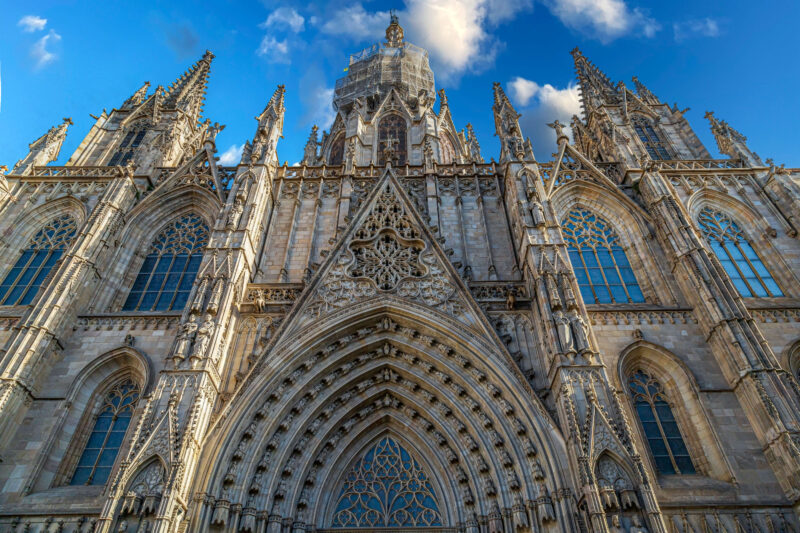Situated at the heart of Barcelona, the Catedral de la Santa Creu, more commonly known as Barcelona Cathedral, is a beacon of historical and architectural grandeur. Its origins are deeply intertwined with the city’s history, evolving over centuries and mirroring Barcelona’s changing fortunes.
History and origin of the Barcelona Cathedral
The Barcelona Cathedral, officially named the Cathedral of the Holy Cross and Saint Eulalia, is dedicated to Eulalia of Barcelona, who suffered martyrdom during Roman times. The cathedral’s site has a long history of religious use, dating back to a Roman basilica destroyed by the Moors in 985.
Construction of the current cathedral began in the 13th century and continued over six centuries, with the main structure completed in the 15th century. The central nave towers at a height of 26 meters, bordered by a series of side chapels. However, the stunning neo-Gothic façade wasn’t finished until the 19th century.
Architectural Significance
The cathedral is a magnificent example of the Catalan Gothic style, with its façade designed in the neo-Gothic style. It houses a choir, two ambulatories, and a beautiful cloister garden, home to a flock of 13 geese symbolising the age of Saint Eulalia at the time of her martyrdom. Inside, the high altar is dedicated to Saint Eulalia, with her remains housed in the crypt beneath.
Current function and use
Today, the Barcelona Cathedral is a functioning church and serves as the Archbishop’s seat. Mass services are held regularly, and it is open to the public for both worship and tourism. Visitors can admire the beautiful interior, complete with stunning stained glass, stone carvings, and historical artwork. The cathedral also provides an elevator to the roof, offering panoramic views of Barcelona’s Gothic Quarter.
The Cathedral as a Christmas hub
From 24th November to 23rd December 2023, the Pla de la Seu square in front of the cathedral transforms into the “Fira de Santa Llúcia“, a traditional Christmas market dating back to 1786. Around 300 stalls sell Christmas decorations, crafts, nativity figures, and festive foods. The beautiful façade of the Cathedral provides a dramatic backdrop to this bustling market, marking it as a must-visit holiday destination.
Ticket price and availability
To visit Barcelona Cathedral, you need a ticket. This ticket has a day and time of entry. Check the price below and book your ticket directly.
Opening hours of the Barcelona Cathedral
| Barcelona Cathedral | Opening hours |
|---|---|
| Monday | 10 am – 6:30 pm |
| Tuesday | 10 am – 6:30 pm |
| Wednesday | 10 am – 6:30 pm |
| Thursday | 10 am – 6:30 pm |
| Friday | 10 am – 6:30 pm |
| Saturday | 10 am – 5 pm |
| Sunday and holidays | 14 am – 5 pm |
How to get to the Barcelona Cathedral
Barcelona Cathedral is centrally located in Barcelona and easily accessible. Check out the transport options below to travel to this cathedral.
By Metro: The Barcelona Cathedral is easily accessible by Metro. The nearest Metro station is Jaume I (L4 – Yellow Line). From the station, the Cathedral is just a 5-minute walk away.
By Bus: Several bus lines have stops near the Cathedral including lines V15, V17, and 45. The 45 line stops directly at Pla de la Seu, right in front of the Cathedral.
By Hop-on Hop-off Tourist Bus: The Barcelona Bus Turístic has a stop at the Cathedral on its Red and Blue Routes. This bus allows you to explore other tourist attractions as well.
By Car: If you’re driving, be aware that parking in the Gothic Quarter can be challenging due to narrow streets and limited parking spaces. The closest parking garage is the BSM Moll de la Fusta Car Park located about a 10-minute walk from the Cathedral.
By Bicycle: Barcelona is a bike-friendly city with numerous bike lanes and rental services. You can cycle your way to the Cathedral and park your bicycle at one of the many bike racks in the area.
On Foot: If you’re already in the city center or staying nearby, the Cathedral is easily accessible on foot. From Plaça Catalunya, it’s roughly a 10-minute walk down Via Laietana or through the enchanting streets of the Gothic Quarter.
